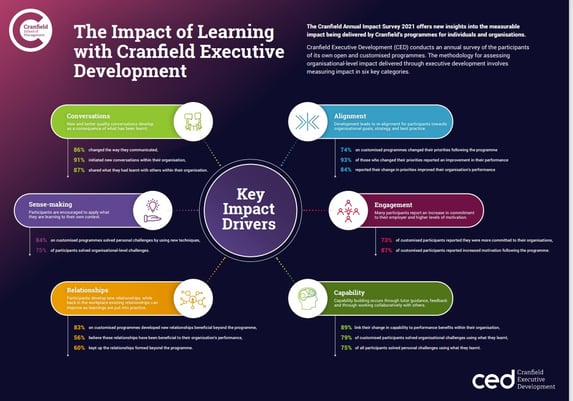Measuring return on investment for executive development can be a challenge.
At Cranfield we recognise this is an important concern for clients and organisations, which is why in 2012 we sponsored Dr Wendy Shepherd's award-winning doctorial thesis investigating how organisational level impact is delivered through executive development. This research has informed the development of Design for Impact™, our unique approach to impact management and measurement.
Every year we survey our learners against the six impact drivers that underpin the Design for Impact™ process. The 2021 report is now published and key results and data can be quickly reviewed in the short video or executive summary, along with the full report - all available in the link at the bottom of this article.
For a more in-depth look at the unique research behind Design for Impact™ read Dr Wendy Shepherd's interview below, where she explains that measuring return on investment in purely financial terms can be misleading.
The Impact of Executive Education
Dr Wendy Shepherd discusses the unique research behind Cranfield Executive Development’s Annual Impact Report
The post-pandemic imperative to ‘build back better’ and reset business to address multiple environmental and social challenges requires the development of agile, entrepreneurial business leaders, able to formulate a vision for the future and motivate their followers to deliver it.
For business schools to play a pivotal role in developing leaders with these characteristics, it is essential that client organisations have faith in the effectiveness of the learning programmes they offer. The Financial Times Rankings are often used as a gauge of executive education effectiveness, however, over 80% of the questions asked by the FT are about inputs such as programme design, methods and content. Very few questions are asked about the outputs or the ‘impact’ the executive programme has had on the individual participants and their organisations.
For organisations, return on investment (ROI) measured in terms of financial return is widely considered to be the ‘Holy Grail’ when weighing the effectiveness of executive education. Based on her research, Dr Wendy Shepherd, Director of Individual and Organisational Impact at Cranfield Executive Development, believes financial measures can be misleading.
“When it comes to financial measures, it is difficult to isolate the impact of development from other activities that are simultaneously taking place within the organisation. Financial measures can therefore at best be misleading and at worst insulting to those not associated with the development who have worked hard to deliver the organisation’s financial performance.”
"Financial measures can therefore at best be misleading and at worst insulting to those not associated with the development who have worked hard to deliver the organisation’s financial performance.”
Shepherd argues that there is nothing to say that ROI needs to be a financial measure and that ROI or ‘impact’ can be measured in other ways.
“Impact is in a sense the same as ROI, in that it tracks what the individual or the organisation has received as a consequence of investing in the development; what the payback has been in terms of outcome for the individual or what has changed within the organisation.”
What’s more, impact may not always be positive. “There's a continuum between negative to positive,” observes Shepherd. “When people say ‘we've had no impact from the development', I think that's unlikely. You'll always have had an impact, but it may be that the impact is detrimental.
“For me, that's why tracking and understanding impact is so important. The output of my research was about managing impact as well as measuring it.” She notes that, when measuring ROI becomes the priority, there is a tendency to wait until the end to ask ‘did it or didn't it work?’ “We really want to know mid-flow whether or not things are hitting home. So, with individuals who perhaps might have left with a poor outcome, changes can be made before the opportunity is lost and the investment wasted.”
Through her research and her award-winning doctorate, Shepherd has identified what she refers to as ‘impact drivers’, which can be used “to link the development intervention with changes within the workplace.” While following one of these impact drivers might lead to a direct financial benefit, other tangible benefits may also be identified.
Shepherd’s six key drivers of impact in executive development:
- Conversations
Executive development provides participants with an opportunity to develop a common language and engage in new topics of conversation. New skills may also develop through participation in facilitated discussion that requires active listening and an ability to present complex ideas succinctly. - Sense-making
Learning initiatives can influence the way learners think about problems. For example, a logical mindset might be broadened by exposure to ideas around emotional intelligence. Changed critical thinking impacts both individual performance and organisational problem-solving. - Relationships
Networks and relationships can broaden as a result of learning interventions. Participants can develop new relationships with members of their own organisation or with attendees from elsewhere. Back in the workplace, relationships can improve as participants put into practice skills they have learnt. - Engagement
Executive development can lead to an increase in discretionary effort and organisational commitment. Participants may have an improved understanding of what is required in their role or respond positively to the investment in their career. There may also be improved engagement within the participant’s team as they benefit from changes in the leader’s performance. - Alignment
Learning interventions can lead to changes in the activities and issues that individuals prioritise, and to a better alignment with organisational aims, culture and strategies. - Skills
When participants return to the workplace with new or improved skills and capabilities, whether that's in functional expertise, self-awareness or leadership, they are often able to address the challenges which had previously eluded them, and make an immediate and impactful contribution to the success of the organisation.
Take conversations, “Conversations may be either positive or negative,” notes Shepherd, “a positive conversation may be about sharing what has been learnt to improve practice, whereas a negative conversation might involve using new insights to provide non-constructive criticism.” It is important, therefore, to not just know whether new conversations have developed but also something about the nature of those conversations.
Based on Dr Shepherd’s research Cranfield Executive Development conducts an Annual Impact Survey, the results of which are presented in an Annual Impact Report. The 2021 impact survey monitored a time when the business school’s clients were having to adapt to remote working and Cranfield had been forced to rapidly accelerate its online learning delivery; innovating in a space of a few weeks to new ways of working remotely that might otherwise have taken several years.
The survey allowed Cranfield Executive Development to identify how the impact of its programmes was affected by these new methods of remote delivery. “The first place you might expect to see impact reduced is in relationships, because people aren't getting the opportunity to socialise as they would on a residential programme. What we actually saw, however, was that people learned how to create and manage relationships via technologies such as Zoom. Many reported that the techniques that they used during their development could also be used to inspire their teams. There were some really good examples where people had used their learning intervention as a way to develop their digital leadership capability and review what their teams would need from them whilst working remotely during the pandemic.”
“The first place you might expect to see impact reduced [during remote delivery] is in relationships, because people aren't getting the opportunity to socialise as they would on a residential programme. What we actually saw, however, was that people learned how to create and manage relationships via technologies such as Zoom."
For many stressed-out businesses, investing in learning during the Covid-19 crisis was unthinkable. This was certainly true for those that view development as a luxury or only as an opportunity to advance careers. But there are many that view development as a driver of individual and organisational performance and a catalyst for solving problems and creating competitive advantage. Shepherd believes that “by understanding more about impact drivers, people can see why they should continue with executive development, even during times when things have started to go a little pear-shaped. Because getting people aligned and engaged, getting conversations going and improving people's relationships and their ability to communicate; what could be more important, particularly during a crisis?”
"Because getting people aligned and engaged, getting conversations going and improving people's relationships and their ability to communicate; what could be more important, particularly during a crisis?”
As Cranfield continues to collect information about the impact of its programmes, it will learn more about what works, and perhaps more importantly, what doesn’t work within specific contexts. This all adds to the knowledge that underpins Cranfield’s unique approach to impact management and measurement ‘Design for Impact™’.
Finally, asked if her research has strengthened her belief in the potential for individuals and organisations to learn and to change, Shepherd has no doubt. “What started out as a theoretical model, of how executive development delivers organisational impact, is now supported by the data from our programmes. We know that the outcomes from executive development are context specific; the knowledge we gain by focusing on impact drivers provides us with new insights that can further strengthen the return from our clients’ investment.”
Dr Wendy Shepherd is the Director of Individual and Organisational Impact at Cranfield Executive Development. She has an MBA and Executive Doctorate from Cranfield where her research interest was The Organisational Impact of Executive Development. In 2021 she won the AMBA and BGA doctoral research prize for the impact of her research.
Wendy's insights have informed practice at Cranfield, including the development of the Design for Impact approach to impact measurement and management. She is responsible for launching our Annual Impact Survey and is the lead author of the Cranfield Executive Development Annual Impact Report.






